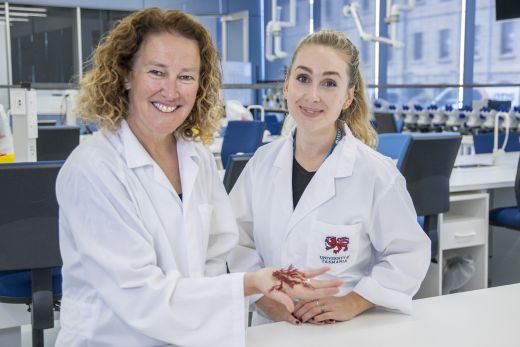
Since the early 1800s, when women in England first hitched up their petticoats and donned boy's outdoor boots to collect seaweed specimens, women have been pioneers in the study of algae and have influenced generations of female scientists to take up seaweed research.
IMAS researcher, Professor Catriona Hurd, has been immersed in seaweed physiology and ecology, called phycology, across her extensive international career – and she is passing the legacy on to emerging phycologists like IMAS University of Tasmania PhD candidate Ellie Paine.
"There is a famous tradition of women seaweed researchers from the University of Liverpool in the UK, where I studied science and became fascinated with the world of seaweed," Prof Hurd said.
"I was lucky enough to meet many of the pioneering women scientists there, including Elsie Burrows who made a major contribution to British post-war phycology – and I was mentored by phycologist Joanna Jones, who was the first qualified woman diver in the UK and possibly the world."
Seaweeds are critically important to the health of coastal ecosystems, creating habitat and providing food for invertebrates like abalone and sea urchins. Most seaweeds enter the food web as small particles or 'seaweed flakes' that feed mussels and oysters.
Popular in Asian cuisine, seaweeds contain many bioactive chemicals, including anti-cancer properties. They also contain hydrocolloids, a gelling agent used across globally significant industries, from food and pharmaceuticals to cosmetics and biotechnology.
"I've worked on seaweeds in the UK, Canada and New Zealand, and now in Tasmania which has the most exciting but most challenging seaweed flora I've ever worked with," Prof Hurd said.
"There are at least 750 species in Tasmania's waters alone, including an incredible diversity of red seaweeds, yet we know almost nothing about the basic biology, physiology and ecology of most of them.
"Here at IMAS, my lab team works on the impacts of ocean acidification and warming on native Tasmanian seaweeds, and on developing three kelp species for aquaculture."
"As a researcher and lecturer, I love to see young scientists joining our phycology ranks and sharing my passion for seaweeds. There is so much yet to discover," Prof Hurd said.
PhD candidate, Ellie Paine, said it was Prof Hurd's passion for seaweed in second year lectures that inspired her to choose phycology as her field of research.
"Most people have heard about Tasmania's Giant Kelp but learning about the diversity of other seaweed groups in our waters, particularly the reds, astounded me.
"I was really excited and wanted to know more, so I applied for an undergraduate research project studying seaweed. That was six years ago and now here I am, finishing my PhD this year, with Catriona as my primary supervisor," she said.
Ellie's PhD is investigating the carbon physiology of seaweeds and how environmental factors may alter seaweed's use of carbon in the ocean.
"I am constantly inspired by females in the traditionally male-dominated fields of science, technology, engineering and mathematics (STEM) – and I love that I'm following in the footsteps of the passionate female phycologists who came before me."
Seaweed research has come a long way since collecting and studying this fascinating marine vegetation was seen as a 'suitable pastime' for women and girls. Not only has phycology evolved as an equal playing field for women scientists, but it has been driven by powerful and influential women. And the story continues…






